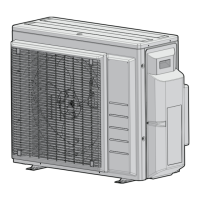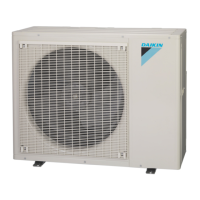7 | Piping installation
Installer reference guide
34
2MXM68+3(A)MXM+3(A)MXF+4MXM+5MXM
R32 Split series
4P600463-1C – 2020.08
4MXM80
Gas piping 1× Ø9.5mm (3/8")
1× Ø12.7mm (1/2")
2× Ø15.9mm (5/8")
5MXM90
Liquid piping 5× Ø6.4mm (1/4")
Gas piping 2× Ø9.5mm (3/8")
1× Ø12.7mm (1/2")
2× Ø15.9mm (5/8")
▪ Piping temper grade and thickness:
Outer diameter (Ø) Temper grade Thickness (t)
(a)
6.4mm (1/4")
9.5mm (3/8")
12.7mm (1/2")
Annealed (O) ≥0.8mm
15.9mm (5/8") ≥1mm
(a)
Depending on the applicable legislation and the maximum working pressure of the unit
(see "PS High" on the unit name plate), larger piping thickness might be required.
Usage of reducers might be required based on the indoor unit. See
"7.2.6 Connections between outdoor and indoor unit using reducers" [4 39] for
more information.
7.1.2 Refrigerant piping insulation
▪ Use polyethylene foam as insulation material:
- with a heat transfer rate between 0.041 and 0.052 W/mK (0.035 and
0.045kcal/mh°C)
- with a heat resistance of at least 120°C
▪ Insulation thickness
Pipe outer diameter (Ø
p
) Insulation inner diameter
(Ø
i
)
Insulation thickness (t)
6.4mm (1/4") 8~10mm ≥10mm
9.5mm (3/8") 10~14mm ≥13mm
12.7mm (1/2") 14~16mm ≥13mm
15.9mm (5/8") 16~20mm ≥13mm
If the temperature is higher than 30°C and the humidity is higher than RH80%, the
thickness of the insulation materials should be at least 20 mm to prevent
condensation on the surface of the insulation.
Use separate thermal insulation pipes for the gas and liquid refrigerant piping.

